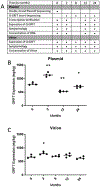Stability of plasmid and viral banks supporting the cGMP manufacture of Q-Griffithsin from a TMV-based viral vector
- PMID: 32553533
- PMCID: PMC7397727
- DOI: 10.1016/j.jbiotec.2020.06.009
Stability of plasmid and viral banks supporting the cGMP manufacture of Q-Griffithsin from a TMV-based viral vector
Abstract
The "whole genome" TMV-based expression system, Geneware®, was used in the cGMP production of the plant-made pharmaceutical Q-Griffithsin and demonstrates stable expression for up to a two-year period. Virion and plasmid banks which contained viral cDNA and a Q-Griffithsin sequence were able to produce >200 g of Q-Griffithsin. Data assessing the quality and stability of the product banks were measured through functional assessments of visual symptomology and product expression.
Keywords: Microbicide; Plant-made pharmaceuticals; Q-Griffithsin; Stability; TMV; Virion.
Copyright © 2020 Elsevier B.V. All rights reserved.
Conflict of interest statement
Declaration of Competing Interest KEP, JLF, and KTH are inventors on patents and patent applications that claim Q-GRFT composition and utility. In addition, KEP, JLF, and KTH are founders and equity holders in GROW Biomedicine LLC, which is commercializing Q-GRFT. EH, JMC, JWS declare no conflicts of interest.
Figures

Similar articles
-
Systemic expression of a bacterial gene by a tobacco mosaic virus-based vector.Proc Natl Acad Sci U S A. 1991 Aug 15;88(16):7204-8. doi: 10.1073/pnas.88.16.7204. Proc Natl Acad Sci U S A. 1991. PMID: 1651497 Free PMC article.
-
High-efficiency protein expression in plants from agroinfection-compatible Tobacco mosaic virus expression vectors.BMC Biotechnol. 2007 Aug 27;7:52. doi: 10.1186/1472-6750-7-52. BMC Biotechnol. 2007. PMID: 17723150 Free PMC article.
-
In Planta production of immunogenic poliovirus peptide using tobacco mosaic virus-based vector system.J Biosci Bioeng. 2006 May;101(5):398-402. doi: 10.1263/jbb.101.398. J Biosci Bioeng. 2006. PMID: 16781468
-
Bulk production of the antiviral lectin griffithsin.Plant Biotechnol J. 2015 Oct;13(8):1160-8. doi: 10.1111/pbi.12433. Epub 2015 Jul 14. Plant Biotechnol J. 2015. PMID: 26176205 Free PMC article. Review.
-
Use of viral vectors for vaccine production in plants.Immunol Cell Biol. 2005 Jun;83(3):263-70. doi: 10.1111/j.1440-1711.2005.01339.x. Immunol Cell Biol. 2005. PMID: 15877604 Free PMC article. Review.
Cited by
-
DNA Oligonucleotides as Antivirals and Vaccine Constituents against SARS Coronaviruses: A Prospective Tool for Immune System Tuning.Int J Mol Sci. 2023 Jan 13;24(2):1553. doi: 10.3390/ijms24021553. Int J Mol Sci. 2023. PMID: 36675069 Free PMC article.
-
A topical rectal douche product containing Q-Griffithsin does not disrupt the epithelial border or alter CD4+ cell distribution in the human rectal mucosa.Sci Rep. 2023 May 9;13(1):7547. doi: 10.1038/s41598-023-34107-w. Sci Rep. 2023. PMID: 37161022 Free PMC article.
-
A Carbohydrate-Binding Protein from the Edible Lablab Beans Effectively Blocks the Infections of Influenza Viruses and SARS-CoV-2.Cell Rep. 2020 Aug 11;32(6):108016. doi: 10.1016/j.celrep.2020.108016. Epub 2020 Jul 24. Cell Rep. 2020. PMID: 32755598 Free PMC article.
-
An algal lectin griffithsin inhibits Hantaan virus infection in vitro and in vivo.Front Cell Infect Microbiol. 2022 Dec 12;12:881083. doi: 10.3389/fcimb.2022.881083. eCollection 2022. Front Cell Infect Microbiol. 2022. PMID: 36579342 Free PMC article.
-
In vitro Study on Synergistic Interactions Between Free and Encapsulated Q-Griffithsin and Antiretrovirals Against HIV-1 Infection.Int J Nanomedicine. 2021 Feb 15;16:1189-1206. doi: 10.2147/IJN.S287310. eCollection 2021. Int J Nanomedicine. 2021. PMID: 33623382 Free PMC article.
References
-
- Shivprasad S, Pogue GP, Lewandowski DJ, Hidalgo J, Donson J, Grill LK, Dawson WO: Heterologous sequences greatly affect foreign gene expression in tobacco mosaic virus-based vectors. Virology 1999, 255(2):312–323. - PubMed
-
- O'Keefe BR, Vojdani F, Buffa V, Shattock RJ, Montefiori DC, Bakke J, Mirsalis J, d'Andrea AL, Hume SD, Bratcher B et al.: Scaleable manufacture of HIV-1 entry inhibitor griffithsin and validation of its safety and efficacy as a topical microbicide component. Proc Natl Acad Sci U S A 2009, 106(15):6099–6104. - PMC - PubMed
MeSH terms
Substances
Grants and funding
LinkOut - more resources
Full Text Sources

